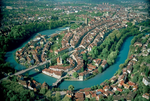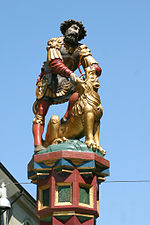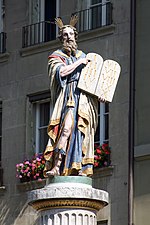Zähringerbrunnen
1530s sculptures1535 worksBuildings and structures in BernFountains in BernInfrastructure completed in 1535 ... and 4 more
Monuments and memorials in SwitzerlandSculptures in SwitzerlandTourist attractions in BernUse British English from August 2017
The Zähringerbrunnen (Zähringen Fountain) is a fountain on Kramgasse in the Old City of Bern, Switzerland. It is a Swiss Cultural Property of National Significance and is part of the UNESCO World Heritage Site of the Old City of Bern.
Excerpt from the Wikipedia article Zähringerbrunnen (License: CC BY-SA 3.0, Authors).Zähringerbrunnen
Kramgasse, Bern
Geographical coordinates (GPS) Address External links Nearby Places Show on map
Geographical coordinates (GPS)
| Latitude | Longitude |
|---|---|
| N 46.947923 ° | E 7.449185 ° |
Address
Zähringerbrunnen
Kramgasse
3011 Bern (Stadtteil I)
Bern, Switzerland
Open on Google Maps










